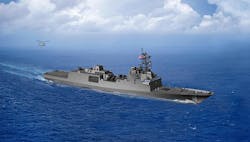The Navy's new FFG(X) frigate warship will be right-sized and -armed for the crucial open-ocean escort role
THE MIL & AERO COMMENTARY – U.S. Navy surface warfare experts took a big step in the right direction in April, as they followed through with a plan to develop a heavily armed blue-water frigate surface warship purpose-built to escort carrier battle groups and high-value convoys.
The Naval Sea Systems Command in Washington announced a $795.1 million contract to Marinette Marine Corp. in Marinette, Wis., to design and build the FFG(X) class of multimission guided-missile frigates.
This new frigate will replace the Navy's Oliver Hazard Perry-class frigates -- the last of which were retired in 2015 -- and an abandoned plan to adapt the Navy's littoral combat ship (LCS) to the frigate's mission.
The yet-unnamed FFG(X) frigate will have the speed, range, endurance, electronics, and armament necessary for open-ocean escort duty and independent operations. It will be sized to fit into the naval surface fleet between the larger Arleigh Burke-class destroyers (DDG 51), and the two smaller varieties of littoral combat ship.
Retirement of the last Perry-class frigates five years ago left a big hole in the Navy's ability to shield valuable surface warships and cargo vessels.
The Perry frigates, first deployed in 1977, were general-purpose escort vessels to protect amphibious landing forces, supply and replenishment groups, and merchant convoys from aircraft and submarines. The Navy built 55 of these ships, which also had the armament and equipment to operate independently.
The Perry-class warship was 445 feet long, 45 feet wide, displaced 4,100 long tons, could steam faster than 29 knots, and had a range of 4,500 nautical miles. The ship had anti-aircraft, anti-surface, and anti-submarine capabilities that included 40 missiles in above-deck launchers, as well as anti-submarine torpedoes.
Navy leaders planned to replace the Perry frigates with blue-water adaptations of the littoral combat ship. This vessel, with a top speed of 47 knots, was to be much faster than the older frigates, but is much smaller and relatively lightly armed.
The LCS, which comes in two variants, is 378 feet long, 57.4 feet wide, displaces 3,900 shorts, can steam as fast as 47 knots, and has a range of 3,500 nautical miles. It has different mission modules for anti-ship and anti-submarine warfare; mine countermeasures; and irregular and amphibious warfare.
The LCS is effective at what it was designed to do: operate near coastlines and harbors in a wide variety of flexible missions, but is lacking when it comes to the kind of open-ocean escort duty that frigates are intended for.
This raises the question: if the LCS isn't up to the job of escorting valuable ships, then why not press the Navy's blue-water-capable and plentiful Arleigh Burke-class destroyer into that role? The answer: the Burke-class destroyers are too expensive and over-qualified for escort duty. Plus, the Burke destroyers are filling the new role of global anti-ballistic-missile defense; they couldn't be wasted just defending the carriers.
The Burke destroyers are 509 feet long, 66 feet wide, displace 9500 tons, can steam faster than 30 knots, and have a range of 4,4000 nautical miles. These ships also have the Aegis combat system for networked anti-aircraft warfare.
These ships are heavily armed, with room for 96 missiles in the Vertical Launch System (VLS), which include the BGM-109 Tomahawk land-attack missile; RIM-66M Standard anti-aircraft missile; RIM-161 Standard ballistic missile defense missile; Mk 141 Harpoon missile. The Burke destroyers also have 5-inch guns, 25-millimeter cannons; and anti-submarine torpedoes.
The FFG(X), meanwhile, will be only slightly smaller than the Burke destroyer, and will be about half the Burke's cost. The FFG(X) will be 496 feet long, 65 feet wide, displace 7,4000 short tons, will steam faster than 26 knots, and have a range of 6,000 nautical miles -- far longer than the Burke-class destroyer, Perry-class frigate, and littoral combat ship.
The FFG(X) will have space for 32 VLS-launch missiles, including the RIM-162 Evolved Sea Sparrow and RIM-174 extended-range Standard missiles; canister-launched over-the-horizon anti-ship weapons; RIM-116 Rolling Airframe Missile, deck gun, and machine guns. Plus, the new ship will accommodate one MH-60R Seahawk manned and one MQ-8C Fire Scout unmanned helicopter.
The FFG(X) will be sized, armed, and equipped for the crucial escort role, and will be a worthy replacement for venerable Perry-class frigate.
About the Author
John Keller
Editor-in-Chief
John Keller is the Editor-in-Chief, Military & Aerospace Electronics Magazine--provides extensive coverage and analysis of enabling electronics and optoelectronic technologies in military, space and commercial aviation applications. John has been a member of the Military & Aerospace Electronics staff since 1989 and chief editor since 1995.
